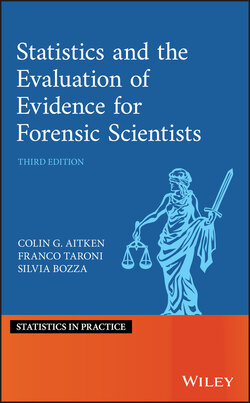Читать книгу Statistics and the Evaluation of Evidence for Forensic Scientists - Franco Taroni - Страница 19
1.3.1 The Frequentist Method
ОглавлениеConsider a consignment of compact disks (CDs), containing disks. The consignment is said to be of size . It is desired to make inferences about the proportion () of the consignment which is pirated. It is not practical to inspect the whole consignment so a sample of size , where is inspected.
The frequentist method assumes that the proportion of the consignment that is pirated is unknown but fixed. The data, that is the number of CDs in the sample that are pirated, are variable. A so‐called confidence interval is calculated. The name confidence is used since no probability can be attached to the uncertain event that the interval contains . These ideas are discussed further in Chapter 4.
The frequentist method derives its name from the relative frequency definition of probability. The probability that a particular event, , say, occurs is defined as the relative frequency of the number of occurrences of event compared with the total number of occurrences of all possible events, over a long run of observations, conducted under identical conditions of all possible events. The limitations of such a definition are presented in Section 1.7.4.
For example, consider tossing a coin times. It is not known if the coin is fair. The outcomes of the tosses can be used as information from which the probability of a head occurring on an individual toss may be assigned. There are two possible outcomes, heads () and tails (). Let be the number of and be the number of such that Then the probability of tossing a head on an individual toss of the coin is defined as the limit as of the fraction . The frequentist approach relies on a belief in the long‐run repetition of trials3 under identical conditions. This is an idealised situation, seldom, if ever, realised in practice. More discussion on the interpretation of such a result is given in Section 3.6.
The way in which statistics and probability may be used to evaluate evidence is the theme of this book. Care is required. Statisticians are familiar with variation, as are forensic scientists who observe it in the course of their work. Lawyers, however, prefer certainties. A defendant is found guilty or not guilty (or also, in Scotland, not proven). The scientist's role is to testify to the worth of the evidence, the role of the statistician and this book is to provide the scientist with a quantitative measure of this worth. It is shown that there are few forms of evidence that are so definite that statistical treatment is neither needed nor desirable. It is up to other people (the judge and/or the jury) to use this information as an aid to their deliberations. It is for neither the statistician nor the scientist to pass judgement (Kind 1994).
The use of these ideas in forensic science is best introduced through the discussion of several examples. These examples will provide a constant theme throughout the book. Consideration in detail of populations from which the criminal may be thought to have come, to which reference is made in the following text, are discussed in Section 6.1.1 where they are called relevant populations. The value of evidence is measured by a statistic known as the likelihood ratio and its logarithm. These are introduced in Sections 2.3 and 2.4.
